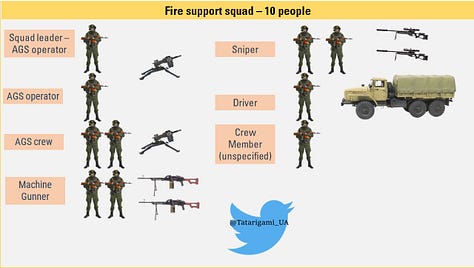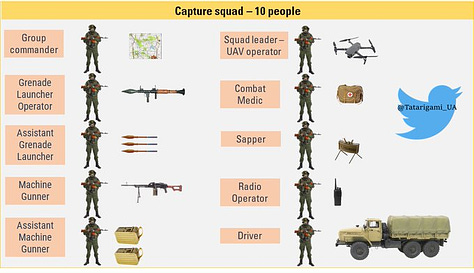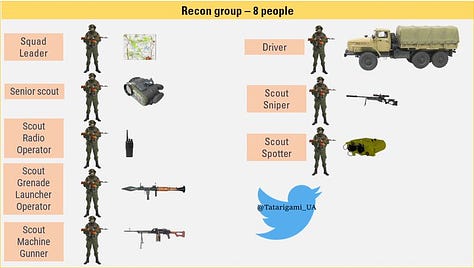![]()

by SIMPLICIUS THE THINKER
A newly written report by retired Australian Army Major General, Mick Ryan, has sent Western presses into fevered overdrive. He makes the bold assertion that the Russian army is adapting and evolving, and that the old, tired stereotypes of Russians being ‘stupid’ are harmful for Ukraine and should be put to bed. And this follows a spate of such similar sentiments on Ukrainian Twitter, Telegram, and other social media. Alarmed by a wave of recent Russian successes, the new customary take appears to be that Russia is ‘wisening up’, and a new reckoning call amongst the AFU-supporting cognoscenti is taking place.

Mick Ryan’s piece was published right here on Substack.
The Modern War Institute at West Point lists his credentials as follows

Maj. Gen. Mick Ryan (Australian Army) graduated from the Royal Military College, Duntroon, in 1989. He has commanded Army units at the Troop, Squadron, Regiment, Task Force, and Brigade levels during his three-decade career.
From 2010 to 2011, Maj. Gen. Ryan worked in the Pakistan Afghanistan Coordination Cell on the US Joint Staff, as the Division Chief for Governance, Development, and Engagement, and subsequently in a new Strategy and Policy Division.
As a general officer, he has served as the Director General Strategic Plans in Army Headquarters, Commander of the 1st Brigade in Darwin, and as Director General Training and Doctrine for the Australian Army.
I’ve quoted him before in my writeup on Russian BTGs.
To his credit, Mick Ryan appears to be one of the least ‘blustery’ and inanely arrogant of the Western generals commentating on this war. He’s on the opposite end of the spectrum to guys like Ben Hodges who spew hateful drivel disguised as hyperbole and propagandistic rhetoric about Russian military capabilities, charged with emotional language that speaks to a personal vendetta rather than clear-minded rational analysis. On the contrary, Mick Ryan’s handling of the war appears to be more balanced, sensible, and at times erudite, albeit pedantically lacking true insight. But for what it’s worth, let’s see what he has to say, and why so many headlines of alarm are being churned out in the wake of his article.
Firstly, he states that Russia’s improvements and ‘evolution’ has come on the tactical rather than the strategic side. He is also one of the few Western commentators that gives credit to Russia’s professional, large-scale withdrawal from Kherson without casualties or equipment losses, attributing a tactical soundness to the maneuver.
Next, he believes due to previous tactical failings, Russia has switched to an attritional model, utilizing slow-crawl advances under cover of massed artillery fires to prevent the types of flanking maneuvers that Russian forces purportedly fell victim to in the early part of the war. This is a fairly pedantically self-evident insight.
Next is Russia’s focus on utilizing the Wagner group in Bakhmut. Ryan here falters a bit. First he slips back to his instincts in erroneously describing Wagner’s attacks as ‘human wave tactics’, which is for obvious reasons antithetical to the bent of his entire post. But then he quickly catches himself and goes on to specify in more detail that they’re actually ‘sophisticated waves’ of echeloned troops with their own unique, well-honed roles.
Thirdly he brings up the recent trend, of which I wrote at length in the earlier pasted article about BTGs, of Russia switching to small unit tactics focusing on assault/shock units specializing in storming fortifications and trench systems. He references the Ukrainian reserves officer’s Twitter account which I likewise used in my post, who wrote at length about the so-called ‘captured Russian field manual’ which describes the new types of Russian assault units and their configurations. We’ll return to the UA officer shortly.
Lastly, he brings up Russia’s switch to utilizing glide-bombs en masse in order to ‘adapt’ to Ukraine’s air defenses, as well as construct their own vast defensive fortifications, replete with ‘dragon’s teeth’, revetments, and everything in between.
As can be seen, most of these observations are rather basic and pedantic. Most of them do not even constitute Russian ‘evolution’ or ‘adaptation’, as it would be condescending towards the Russian forces to believe such basic approaches are major advancements from previous conduct.
The truth is, one thing I realized is that Western commentators and ‘analysts’ love to disguise their own failed predictions and poisoned narratives with the canard of Russian ‘evolution’. Most of the top Western pundits’ analysis has proven wrong in this war, and so now in order to save face and maintain an air of rectitude they use the false paradigm of a ‘sudden, unexpected’ Russian ‘evolution’ as a sort of cognitive dissonance for their own failings.
As I said, to believe Russia massively “evolved” into these very basic tactical understandings is to believe that the Russian army’s previous state of operation was some “dumb Mongoloid barbarians” caricature. It’s as if Russia only just now ‘figured out’ that they can outrange enemy air defense with bombs that have greater range. This is in similar fashion to the tropes about “Russians learning how to use indoor plumbing”, etc.
Not a single one of these ‘advancements’ are moments of light-bulb-sparking ‘insight’, but rather very straightforward, logical continuations of Russia’s new objectives following the end of the first phase which attempted to subdue Ukraine bloodlessly by way of pure offensive intimidation. To say that Russia has ‘evolved’ to using their artillery advantage in order to lessen casualties is to basically admit you have never studied Soviet warfare and military doctrines.
With that said, I do believe Russia is very subtly innovating and experimenting, but it is doing so in ways that go over the head of the basic, superficial observations most of these Western analysts are capable of making.
For instance, it is true that Russia is experimenting more with small unit tactics; but it’s obviously something done out of necessity, and it’s not like it’s completely new territory to them. While we can call it a form of ‘adapting’, as I said before, it’s not some rare lucid moment of sudden insight that the mongrel orc horde has been struck with, but rather a direct, logical continuation of the shift in military objectives that occurred last year.
To get back to the previously mentioned UA officer, he has recently posted a new Russian manual claimed to have been captured in the field, which talks about another new type of unit called ‘Storm Z’ that Russia is experimenting with. You can see his Twitter thread on it here:
Thread🧵
I obtained a russian document titled "Regulation on Storm Units Z of the 8th Combined Arms Army." This document outlines the objectives, organization, and logistical requirements of 'Storm Z' units. After analyzing its contents, I have distilled the main points. pic.twitter.com/vY5cqqzQRw
— Tatarigami_UA (@Tatarigami_UA) April 6, 2023
The document defines “Storm Z” Company as an independent, joint, tactical, combined-arms company temporarily created outside the regular army corps unit structure for immediate operational use in performing particularly complex combat missions.
These units are reportedly meant to be trialed in motor rifle brigades of the 1st Army Corps, 150th Division, and the 4th, 6th, 7th, 110th, 123rd, and 132nd Separate Motorized Rifle Brigades. Most of these, off the top of my head, appear to be units in the southern direction, around DPR/Donetsk, which would make sense as that’s where assault style operations are currently most prevalent. This is in contrast to the northern front, like Kremennaya, where on average it’s more of a defensive operation with occasional assaults handled by the paratroopers.
He provides a few slides, such as the following:
And states that the goals of these ‘Z Companies’ are as follows:
The goals of the Storm ‘Z’ company are:
• To conduct combat operations in a city (settlement) or areas with difficult geographical conditions.
• To capture important objects such as strongholds, command posts, communication centers, buildings, structures.
• To carry out sabotage operations in territories controlled by the enemy.
• To search for and destroy sabotage and reconnaissance groups.
• To block structures and eliminate enemy forces within them.
• To adjust artillery fire and air support
In short: they are specialized assault units, which is no different to last time’s ‘captured manual’ which focused more on the actual tactics of new assault groups.
Though once again, there’s no proof that these documents are real, but as last time, there is nothing intrinsically defamatory about them that would lead us to conclude they’re some type of psyop meant to reputationally damage the Russian army.
“Storm Company Z” (100 personnel) structure:
4x Capture Squad (10 personnel each)
4x Fire Support Squad (10 personnel each)
1x Company Command (2 personnel)
1x Combat Engineering Group (5 personnel)
1x Reconnaissance Group (8 personnel)
Here is the part most analysts have missed, where the true innovations of the Russian campaign are happening. It is in the fact that Russia is utilizing PMCs (Private Military Contractors) as experimental test beds for new tactics, given that for obvious reasons PMCs are able to accommodate more ‘risk-taking’ since their losses are mostly off the books and they are in effect ‘expendable’ compared to soldiers of the Russian army proper. I’m not saying Russia actually treats them as expendable, but simply that, if you had the choice between the two, of course you’d do the riskier experimentation with the PMCs.
Russian command is then watching and learning the various prototyped tactics and applying them to the regular army. And recently this has begun to take on a more direct approach as Wagner PMCs are now outright training up to three Russian Motorized Rifle Brigades from mobilized Russian troops, and according to some, even paratroopers.
“Wagner-affiliated sources announced on April 17 that Wagner is training up to three motorized rifle brigades of mobilized personnel to reinforce Wagner‘s flanks in Bakhmut,” the institute said.
Ukraine’s eastern forces spokesman Serhiy Cherevaty confirmed the collaboration between paratroopers and Wagner mercenaries. – Source
You can see a video of Wagner announcing this themselves here: LINK.
And a general greater integration is happening between PMCs and Russian armed forces proper, as Putin just decreed that all PMC and volunteer groups will be eligible for ‘veteran’ status equivalent to that of full Russian army combat troops.

Everyone who risks his life today protecting our country during the course of the SVO [special military operation] should have an equal status as a combat veteran, should be assured that the government will take care of him and his family regardless of whether he was a soldier, an officer, a volunteer, or anyone who participated in carrying out the SVO.
As I mentioned, it’s too risky to ‘experiment’ with assault tactics in particular while utilizing regular troops whose losses have major political consequences that can sway the tenor of the conflict. But utilizing PMCs to first experiment with different structures, tactics, etc., during high-casualty-prone assault maneuvers is ideal. Then passing that gained knowledge down to the actual Russian forces by way of a greater integration of the two is the clearly logical step, and is exactly what Russia is currently doing.




